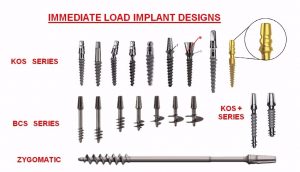
BASAL IMPLANT DESIGN /TYPES
Structure/Design of Basal Implants
1.Lateral basal implant (Basal® brand) with the large horizontal plate and reduced vertical implant portions.
2.Basal compression screw (BCS® brand) with large thread for cortical engagement.
Lateral basal implants
Lateral basal implants are inserted from the lateral aspect of the jaw bone. With a disk-diameter of 7mm or more, they are inserted through a T-shaped slot in the jaw bone.


Screwable basal implants
Screwable basal implants (BCS® brand) are flapless implants and are placed through the gum, without giving a single cut.


There are different designs of Basal Implants. e.g. BCS, BCS Ex, KOS, KOS Plus etc. These implant designs are considered to be the perfect choice for immediate loading and give long lasting satisfaction to the patient.
KOS Implants
These implants are single piece implants with compression threads designed for immediate loading in healed bone.
These implants compress the bone around the implants, thereby achieving high stability of implants which helps in higher stability of implants for immediate prosthetic loading.


BCS Implants (Bi Cortical Screws)
These implants are polished smooth surface implants with “no-itis” surface which are placed taking anchorage from the 2nd or 3rd cortical bone and are ideal for full mouth rehabilitation, immediate extraction cases, periodontally compromised cases or in “no- bone” situations where the implants have to be loaded following immediate loading protocols.


KOS Plus Implants
These implants are a combination of KOS and BCS implants where there is a rough surface like KOS implants and at the apical part, there are smooth surface threads like BCS implants.
These implants are ideally used in upper anterior teeth replacement, wherein the smooth apical threads are anchored in the nasal bone (2nd cortical) and the rough surface of implants lie in the cancellous bone giving better retention.


BCS Ex Implants
These implants are polished smooth implants with “no-itis” surface which are ideally placed in reaching the 2nd cortical at the pterygoid bone, in immediate extraction sockets and in full mouth rehabilitation cases.
Even high-risk groups such as smokers, diabetic patients and patients with severe gum disease can successfully receive these implants.


